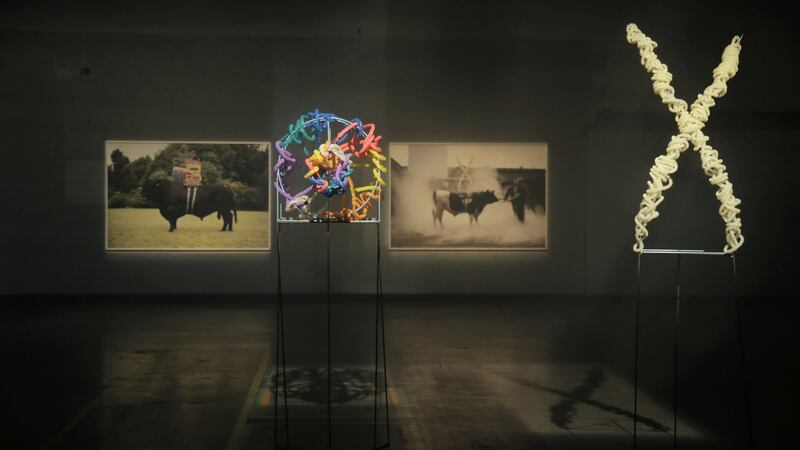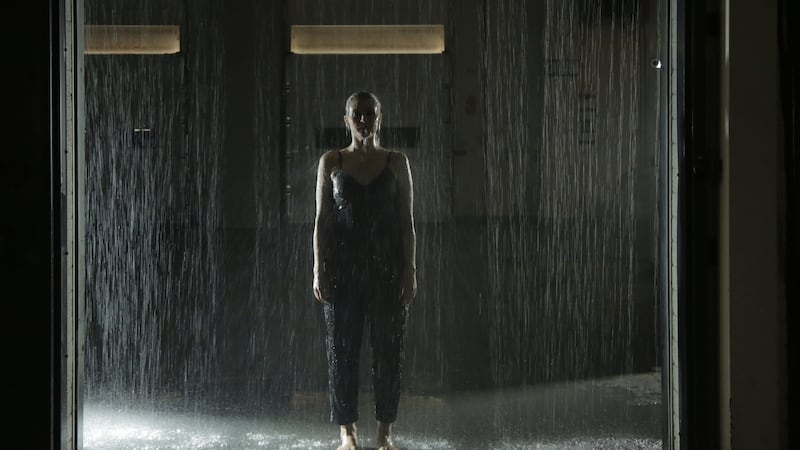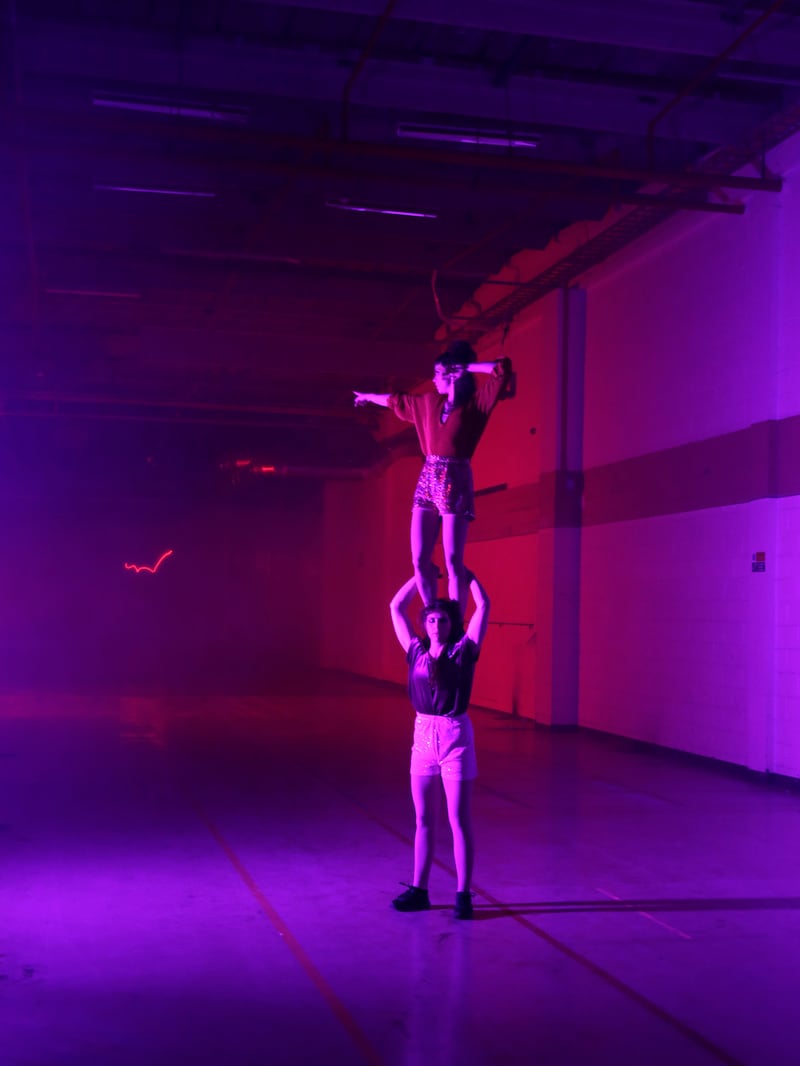A 72-hour lost weekend, at the best party you’ve never been to, in a cavernous secret gaff. Sound works, light installations, live music and dance, visual art, a 360 virtual exhibition space. How enticing does that sound?
On the northeast outskirts of the town of Carlow, in Rathnapish, the giant stack of the Braun factory looms, a longstanding landmark of an arrival point into the town. The vast modernist complex is a reminder of Carlow’s industrial history; in 1974 the German electrical manufacturer set up in the large regional town, becoming at one stage its biggest employer with 1,400 workers, mostly women, manufacturing small personal appliances and later electric toothbrushes. It closed in 2010, a significant loss to the town.
Now it’s opened again – temporarily – for Woman in the Machine, co-created by the town’s two major arts organisations, Carlow Arts Festival and VISUAL, presented as part of Brightening Air (Coiscéim Coiligh), a nationwide, 10-day season of arts experiences from the Arts Council. The large scale event with multiple threads, includes a three-day Carlow Arts Festival event at the giant, abandoned factory.
Woman in the Machine, created by a female team and featuring creative work by multiple Irish women, focuses on the intersections of art, science and digital media. Inspired by the site, which Mangan describes as having the feeling of an East German arts centre/squat, as well as Lisa Rovner’s film about female pioneers in sound Sisters with Transistors, the multidimensional experience includes film, visual art, installations and a 360 virtual festival space.
Today it’s bright and sunny and the giant shuttered factory is a hive of activity. Just inside the loading bays there’s a makeshift make-up room, a coffee stand and a huddle of open umbrellas on the ground. These aren’t a creative gesture but a safety block around two holes. There are puddles on the floor, some from leaks, but others possibly from filming that morning, of a scene where dancer Sibhéal Davitt moves through a wall of water.

You step from there into this magnificent space, what was once a vast factory floor, with industrial roof girders, metal pillars, smooth concrete floor. The light is atmospheric, from sparse windows and large lamps in some areas, rigged up for the project. With no water or electricity, it took a massive get-in by a large crew to bring this place back to temporary life.
There are multiple pockets of diversion and activity dotted within the expanse. On a silk hanging from the roof, a Tumble Circus acrobat practices. Two large-format photographs of cows with sculptures on their backs – Maria McKinney’s work at the intersection of agriculture and technology – are illuminated on a wall in another part; the sculptures are on plinths nearby, still in wrapping. Sidestep some floor vinyls – How will you care for me, designed by Michelle Doyle, Cóilín O’Connell and Eva Richardson McCrea, from Braun drawings and instruction manuals. Way down, past an enormous film screen, red stained glass colours the corner, and two mic stands with headphones perched are like expectant ghosts waiting for a performance. Walk through the hall – for some time – and pass a gazebo-lantern structure, where Seve Feathers performs later, and Hesperidae, a mesmerising, immersive moving light projection by Helen McMahon.
Peer to the left, past what looks like a row of control rooms, eerily lit in luminous green, and what’s that? A giant Spraoi goat puppet, waiting in the corner, as if for some action.

In this surreal, noir setting Carlow Arts Festival director Jo Mangan and Emma Lucy O’Brien, artistic director of Visual Carlow, are describing how they are “like crazies”, in the middle of creating, for a film they are shooting over three days. We go deeper into the beast, past a balcony where DJ Kate Butler from Dublin Digital Radio will play a set, and Liliane Puthod’s neon installation on the wall, and step into a gap in a large horizontal digital artwork comprising eight screens: Barbara Knezevic’s Techne Touch tells the history of the world in digital or computer-generated stock photos.
To the side is the towering five-storey stack, part of the complex added in the 1990s, with the word Braun on the outside. Inside are giant storage racks, part of a sort of robotic dispatch system. A string of lights on the floor illuminates it, where a band will play.
In another cavernous factory hall the crew is filming two acrobat/dancers, Angelique Ross and Michelle Thoburn of Snatch Circus, tumbling and cavorting along a wall.
“Despite its size,” the Braun building “has always seemed impenetrable, private and slightly mysterious” writes architect and lecturer Emma Geoghegan, who is working on another aspect of the project, Engaging with Architecture.
There has been great curiosity over the past weeks from locals about seeing inside the shuttered behemoth that thousands in the town knew for decades. “We’ll have to manage that expectation,” observes Mangan.
Viewer limit
The original plan was to bring the public into the Braun building, for the festival’s 72-hour lost weekend performance and exhibition. And standing in here, you could envisage fitting hundreds of people in the space, still with oodles of metres for social distancing, and tons of air circulation up into the high roof. Weep for what could have been; but the Best Party is indeed the party you’ve never been to. Despite the gradual reopening, live performance is not permitted indoors, even in a vast space like this, and only 15 can attend outside at one time. It is somewhat heartbreaking. And yet, the team are finding a way to create that party in a different way.
This has four iterations. First, Mangan is producing the film of this cornucopia of 50 plus original arts projects with work by hundreds of artists and arts workers in this stunning space. The film sounds like a riot, with electronic compositions, live music, DJ sets, large scale installations, dance and circus performances, masses of visual art including film and sculpture.
Second, there will be a live in-person experience in the grounds during the arts festival – rolling performances daily for up to 15 people at a time – with the 72 Hour Lost Weekend film screened from within the loading docks, and outdoors, live music, rollerskaters, art installations. An Engage with Architecture exhibit will skirt the site’s perimeter, with the Braun stack illuminated.

Third, Woman in the Machine’s commissioned works, from an open call and invited submissions by artists working at intersections between art, science, technology and new media, as well as from the Arts Council Collection, will then transfer to Visual for the summer. Alongside will be the Braun archive (research on the social and cultural history of the building, architectural drawings and digital models, and speculative ideas for its future) from Emma Geoghegan and five TU Dublin School of Architecture fourth year students. The public is invited to share memories and memorabilia.
Lastly, the constituent elements are online, and there’s a significant virtual reality strand in a 360 immersive interactive online alt space, with digitally native and sound work, music and film.
Woman in the Machine is on the Braun 30-acre site thanks to the generosity of its owner, entrepreneur/ex-Dragon’s Den investor/ex-presidential candidate Sean Gallagher, who bought it years ago from Procter & Gamble. There was an earlier plan to create a corporate and technology park, but it’s now for sale for €6 million. Mangan is furiously doing the sums: “If we had 24 people with €250k each… think what could be done with this”, in terms of performance and creative space. O’Brien says: “Imagine the words ‘Carlow Film Studios’ there on the side.”
Emma Lucy O’Brien of Visual says: “Townscapes are continuously changing, industries move on, technologies change, life responds and adapts. Braun in Carlow resonates for people in different ways; an edifice, a workplace, a landmark.” Mangan says it “dominated my imagination certainly since first arriving in Carlow”, talking about being a fan of “between life” spaces, and how she’s “always on the hunt for that sweet spot in a building’s life when artists are welcome to come and reimagine that life briefly”.
Woman in the Machine (filmed experience, virtual space and in person) runs June 11th-13th WomanInTheMachine.com, co-created by Carlow Arts Festival (June 4th-13th; carlowartsfestival.com), and Visual Carlow visualcarlow.ie, where it runs until the end of September. Presented as part of the Arts Council's June programme Brightening Air/Coiscéim Coiligh brighteningair.com. Most is free to attend (aside from the live experience: €5 booking essential).











